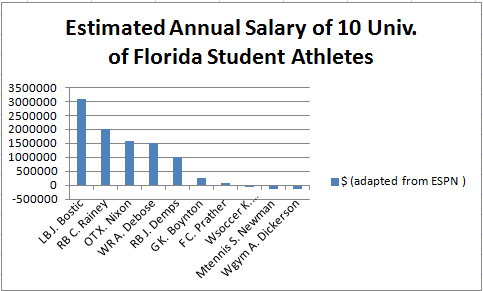I think the short answer is that some of them should be paid.
Harold Pollack and I discussed whether college athletes should be paid on bloggingheads last week. Harold’s position is that asking whether paying athletes will harm college sports is the wrong question and I find his argument convincing. Talking with Harold over the past few weeks helped me to realize that I approached the issue as a fan who thinks there are benefits (and costs) that are broadly distributed via college sports, but there are issues of economic justice in play. This lead me to suggest the following for football and men’s basketball, the sports in which questions about economic justice are largest:
- Scholarships should cover the full cost of attendance
- All players in these two sports should get a modest “spending money” stipend
- Star players should receive a share of the money earned from the sale of their likeness and/or jersey
An analysis in a story by Ryan McGee in the latest issue of ESPN The Magazine generally supports my idea, I think. ESPN worked with Jeff Phillips and and Tyler Williams of MIT’s Sloan Entertainment, Media and Sports Club to estimate the fair market salary that 10 University Florida student athletes would receive if they were able to openly and freely shop their talents. A figure adapted from the story that I created is below
The five football players analyzed would receive an estimated salary of between $1 Million and $3.1 Million* per year; these are star players as these 5 would receive a total of around $9 Million of the $57 Million annual football profit (football teams get 85 scholarships, though there are likely over 100 players counting walk ons). The two men’s basketball players (Boynton and Prather) are also team stars, but their “salary” would be lower based on the much lower profitability of men’s basketball v. football at the University of Florida (basketball gets 12 scholarships). The other three athletic programs lost money.
Such an analysis would differ from school to school, but the upshot of the story by McGee is that football is the real economic powerhouse in NCAA sports, with men’s basketball being the only other sport that consistently turns a profit at most universities. A system by which all players on teams in the two most profitable sports received some compensation beyond going to school for free with a small number of stars receiving large sums, the amount derived by some sort of market signal, would seem to be a positive change.
*The estimates were based on the net income of 5 sports programs at University of Florida (football $57.7 M, men’s basketball $1.4M, and losses of between -$1.1-$1.9M for the other three sports). The print article states the full methodology for how they assigned the different salary for the 5 football players, for example, is at ESPN.com/insider but I cannot find it on the free side of a paywall. For the football players LB=line backer; RB = running back; WR= wide receiver; OT= offensive tackle. For the two basketball players G=guard and F=forward.
update: tweaked a bit of the language.


